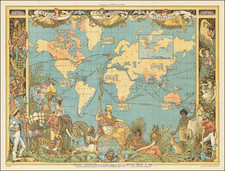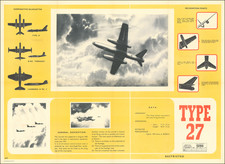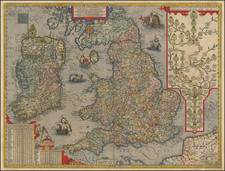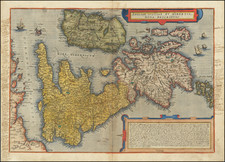World War I Propaganda Handkerchief—A Rare Great War Cartographic Keepsake
Striking, color-printed handkerchief of the British Isles and part of France, showing a British Tommy heading for the Western front, waving to his imagined wife or sweetheart. While keepsakes for soldiers were common in WWI, map-themed keepsakes are quite rare.
His sweetheart (or family) is personified by each of the four home nations in distinctive dress with the words, “It’s a Long, Long, way to Tipperary, My Heart Right There,” written above Scotland. They wave their own handkerchiefs with flags or significant colors on them.
On the handkerchief, the topography of Britain is depicted along with the locations of towns and cities across the isles and northern France.
It’s a Long Way to Tipperary
“It’s a Long Way to Tipperary” was a music hall song which gained popularity in 1914 as World War One was still in its infancy. It was enjoyed amongst Irish soldiers initially, proceeding to spread to soldiers from other parts of the UK. Thanks to the intermingling of international soldiers on the frontline of WWI, the song became popular worldwide.
The choice of this song makes this handkerchief more than just a general keepsake to remind soldiers of home. By focusing on an Irish song as a symbol of the Union, the handkerchief shows Ireland as a partner and part of the Union, and not a subject of it, marking it as a piece of anti-Irish independence propaganda as well.
The state of the British Union during WWI
The handkerchief offers a sense of British unity, which was more of a hope than a reality at this time. While there had historically been a contingent of the Irish who were disgruntled by English rule, the desire for independence exploded during and after the First World War.
In 1914, the British Parliament passed the Home Rule Act, which would devolve political autonomy to Ireland. But this act was quickly suspended for the length of WWI, inciting Irish nationalist tensions. These issues reached a boiling point in 1916, when, on Easter Day, several thousand Irish rebels attempted to stage an insurrection in Dublin. While this rebellion did not succeed, the tension simmered on.
In 1918, it was clear that the people of Ireland wanted independence, with 73 out of the 105 Irish parliamentary seats being secured by Sinn Fein (the Irish nationalist party). The incident that unbalanced this precarious situation took place in Tipperary where, in 1919, some Irish Republican Army members shot two British Constables, igniting the Irish War for Independence.
Unlike Ireland, however, Scotland acted as an energetic partner with England in the war. The overpopulated cities of Edinburgh and Glasgow proved fertile ground for the recruitment of soldiers. Even more Scots signed up to fight when the British government guaranteed a weekly stipend for the surviving family of soldiers who died in the war. Ultimately, Scotland provided disproportionate support for WWI by contributing fifteen percent of the total soldiers in the British Army, despite being only ten percent of the British population.
Additionally, the increased demand for military goods bolstered both light and heavy industry in Scotland, causing an economic boom. Most strikingly, however, was that the ship building industry expanded by one third. Since a significant portion of Scottish men were out fighting, this economic boom greatly increased the economic resources of women, who made up seventy percent of the work force during the war.
Keepsakes in WWI
Keepsakes were common amongst soldiers of all countries fighting in WWI, with the most common themes being loved ones, home, and nationalism. These items were meant to offer some comfort to soldiers who were in a highly stressful situation.
This handkerchief contains all the main themes common amongst WWI keepsakes. By marking large towns across the UK, soldiers would be able to point out where they were from to others. The women on the maps represent the hypothetical sweethearts of the soldier being sent to the front, and the map of the UK was a symbol of nationalism. This handkerchief has survived the tumultuous environment of the WWI trenches, and is a rare WWI map keepsake.











![[Foreign Ship] [lkokusen]](https://storage.googleapis.com/raremaps/img/small/55568.jpg)


![Indigotoire [Indigo Plantation]](https://storage.googleapis.com/raremaps/img/small/92080.jpg)